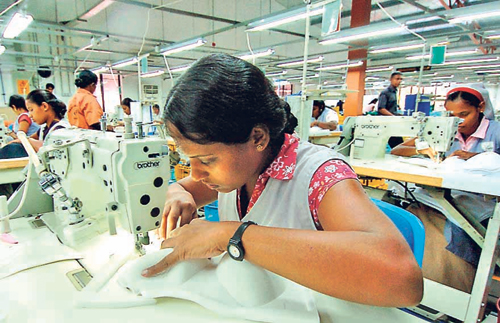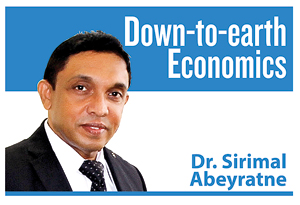Debtor, turning into a creditor…
View(s):
File picture of a garment factory. Apparel export revenue has also suffered owing to the pandemic.
The Sri Lanka – Bangladesh currency swap has received much attention during the past two weeks. In fact, the news hit the headlines in both India and Bangladesh as well. The Daily Star of Bangladesh reported on May 26 quoting a spokesman from a bank that for Bangladesh “…it is a good ego booster” but raised the question that “…what if Sri Lanka becomes insolvent?” as the sum being lent is not small. On June 2, the Indian Express carried a column explaining the currency swap as a historic landmark: While it is the first time for Sri Lanka to ask for financial assistance from another SAARC country other than India, it is also the first time for Bangladesh to provide such assistance to a foreign country.
According to a Pakistani economist from “The News” on May 24, “…it is in the realm of possibility that we [Pakistan] could be seeking aid from Bangladesh in 2030.” Finally, it didn’t take that long and neither was it Pakistan!
Currency swaps
Today, I thought of bringing out an exciting story. It is not about the currency swap, nor about Sri Lanka’s economy. It is about how Bangladesh elevated itself from being a debtor to the state of a creditor within such a short period of time.
Before that I must also explain what a “currency swap” means. It is an “exchange of currencies” for a specified period at a specified interest rate. In the above case, it is a loan from Bangladesh to Sri Lanka in US dollars in exchange for an equal amount of Sri Lankan rupees with an agreement that the two currencies will be re-exchanged in due time with an interest rate. Because it is Sri Lanka that needs US dollars and, not Bangladesh which needs Sri Lankan Rupees, Sri Lanka will have to pay back the US dollar amount with interest.
As per the initial swap of a larger amount of US$500 million, Sri Lanka is receiving from the Bangladesh Central Bank $200 million which must be settled in a 3-month period with the interest at LIBOR plus 2 percent. As the international interest rates are closer to zero now, the 3-month LIBOR, which is the London Inter-Bank Offer Rate, is around 0.1 percent only. Therefore, the currency swap is cheaper than other forms of international borrowings in order to meet urgent foreign exchange shortages.
Basket-case of South Asia
My first visit to Dhaka – the capital city of Bangladesh, which was about 25 years ago -, was a whole new experience to me. The city was dusty, messy and noisy; roads and streets were full of people, animals, tuk-tuks, rickshaws and vehicles – of course, all the vehicles were full of cuts, dents and scratches all around. Motor cars had iron bars fixed on both front and rear sides in order to protect the vehicles while causing damage to others.
 While Bangladesh is one of the most populated countries in the world with 166 million people, Dhaka alone is as big as the entire Sri Lanka; it has 21.7 million people. What you see the most everywhere in Dhaka was poverty because Bangladesh was one of the poorest countries in the world. When Bangladesh was declared as an independent state in 1971 after the war with Pakistan, it was not seen as a country that can survive. Extreme poverty, famine, and diseases had got aggravated in the midst of the war, while there was no economic base in order to deal with these issues. In a famous statement, US State Secretary, Henry Kissinger said it was a “basket-case”.
While Bangladesh is one of the most populated countries in the world with 166 million people, Dhaka alone is as big as the entire Sri Lanka; it has 21.7 million people. What you see the most everywhere in Dhaka was poverty because Bangladesh was one of the poorest countries in the world. When Bangladesh was declared as an independent state in 1971 after the war with Pakistan, it was not seen as a country that can survive. Extreme poverty, famine, and diseases had got aggravated in the midst of the war, while there was no economic base in order to deal with these issues. In a famous statement, US State Secretary, Henry Kissinger said it was a “basket-case”.
In a peculiar way, the country is surrounded by India from its western, northern and eastern sides. For the same reason, one of the major problems for India was how to control illegal Bangladeshi immigrants who frequently attempted to escape from their misery in the home country. The southeastern corner of the country has a small stretch of land boundary with Myanmar, while the Southern boundary was open to the Bay of Bengal which has very little economic activities.
Bangladesh is a land with low altitude. The matter continued to remain crucial due to many rivers flowing from northern high altitudes through India converged in Bangladesh, including the big ones such as Ganga, Jamuna and Brahmaputra, and reach the Bay of Bengal. Therefore, the country is prone to frequent floods as well as to water-borne diseases, adding more ingredients to its socioeconomic problems. The problems got aggravated even more, because the country was designated as one of the most-corrupted nations in the world, as per the Corruption Perception Index.
Richer than the neighbours
To the surprise of all its neighbouring countries as well as to the world, things started to change, however. It all began with the opening of the economy after 1990 and shifting of the development strategy from import substitution to export promotion. Trade liberalisation and export promotion strategies attracted investment to export industries, seeking the advantage of an abundant youth labour force. The past two decades reported impressive growth of GDP and its labour-intensive export products.
In 1999, both Sri Lanka and Bangladesh had the same level of exports of goods and services worth $6 billion. After 20 years by 2019, while Sri Lanka has raised its exports 3-times, Bangladesh was found to have increased it by nearly 8-times.
The past 10-year period was impressive for the growth of the Bangladesh economy as the annual real rate of GDP growth remained in the range of 6 – 8 percent. Last year, when the neighbouring countries were reporting negative rates of growth due to the COVID-19 pandemic, Bangladesh recorded 5.2 percent growth. With this change, Bangladesh should now be richer than both India and Pakistan in terms of per capita income. This could be a hard truth for many in South Asia to believe – a country once considered to be a poorest of the poor has been rising from scratch and surpassing others in the neighbourhood.
If Bangladesh was capable of doubling its per capita income in less than 10 years, it is quite possible that the country can exceed $4,000 per capita income level in another 10 years and enter the “upper-middle” income countries.
Coping with COVID-19
Bangladesh was also hit hard by COVID-19, although it was not as bad as India. Despite being an over-populated country with an over-populated capital city, Bangladesh has reported nearly 1 million positive cases and 13,000 deaths (77 per million people) – much lower than the case of its neighbours.
It is important to note that the Bangladesh economy is on a strong footing to cope with the negative socioeconomic impact of the pandemic. In addition to strong growth performance and export expansion, the country has maintained a healthy fiscal prudence throughout. Government spending has been contained to 15 percent of GDP and, budget deficit at around 5 percent of GDP.
Bangladesh has been borrowing from both multilateral and bilateral donors but continued to maintain the debt ratio to keep it under 50 percent of GDP. Throughout the past 20 years, the debt-GDP ratio has been falling so that at the time the pandemic hit the economy, it was below 30 percent of GDP.
Strong export growth has helped the country maintain a stable exchange rate and, to build the country’s foreign exchange reserves. The stock of foreign exchange reserves is now at $45 billion, which has increased from $35 billion just a year ago.
IMF assistance
The IMF on May 29 announced the approval of $732 million emergency assistance for Bangladesh to face the challenges posed by the pandemic. The IMF has also acknowledged the commitment of the Bangladesh government to “promoting strong and inclusive growth while preserving macroeconomic stability”.
If you are looking for a short answer to the question how Bangladesh sustained that strong and inclusive growth and preserve macroeconomic stability, I must say that it is export growth and sound budget. I must also tell you another secret: It is a country that keeps religion out of politics.
Anyway, if I don’t outline the emerging challenges of Bangladesh this write-up is incomplete. Everything is not rosy, and obviously Bangladesh has a lot more to do and a long way to go without depending too much and too long on apparel exports. Somewhere on the growth path, lack of advanced-technology and high-skilled labour will be the binding constraints which may pull down long-run growth for any country.
(The writer is a Professor of Economics at the University of Colombo and can be reached at
sirimal@econ.cmb.ac.lk and follow on Twitter @SirimalAshoka).


